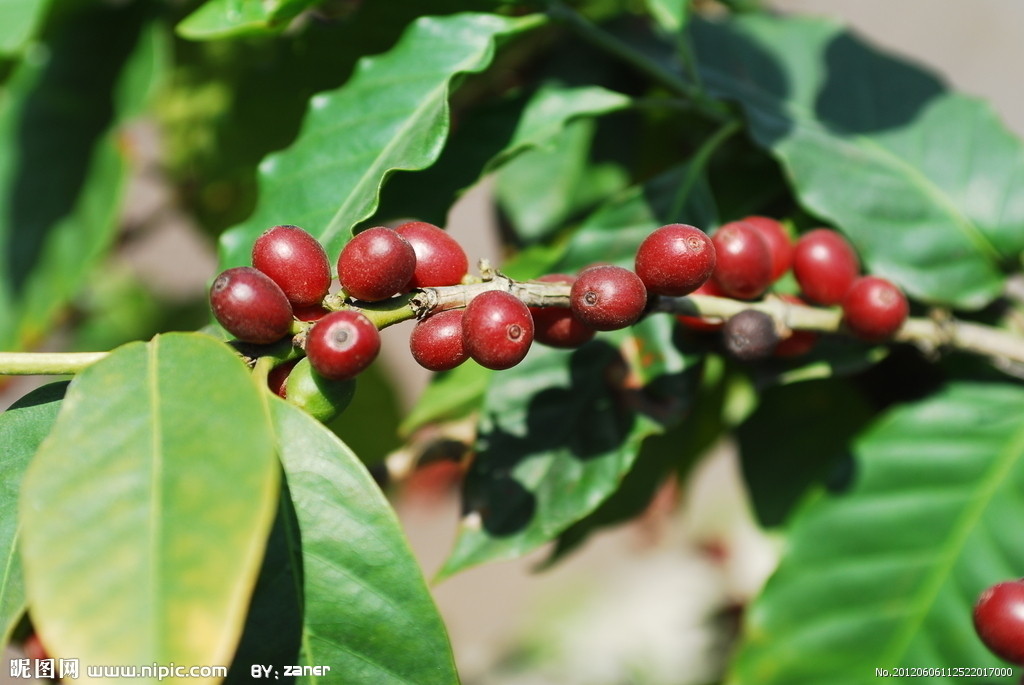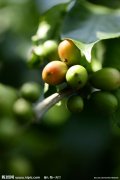Coffee basic knowledge what conditions do you need to grow coffee?

Coffee is a perennial evergreen shrub or small tree of Rubiaceae. It is a kind of horticultural perennial economic crop with the characteristics of fast-growing, high yield, high value and wide market. Wild coffee trees can grow to 5 to 10 meters tall, but coffee trees grown on plantations are often cut to less than 2 meters in height to increase fruit yield and facilitate harvesting.
Coffee tree opposite leaves are long oval, leaf surface smooth, terminal branches are very long, few branches, and flowers are white, open at the base of the petiole connecting branches.
Mature coffee berries look like cherries, are bright red, sweet flesh, containing a pair of seeds, that is, coffee beans (Coffee Beans). Coffee varieties are small, medium and large seeds of points, the former contains low caffeine content, aroma, the latter two high caffeine content, but some poor aroma.
At present, the coffee sold in the world is generally prepared from small and medium seeds in different proportions, usually 70% of the medium seeds, mainly taking their caffeine; 30% of the small seeds, mainly taking their fragrance. Each coffee variety generally has a few to a dozen variants. Coffee is more tolerant to shade and cold, but it is not tolerant to light, drought and disease. Coffee contains caffeine, protein, crude fat, crude fiber and sucrose and other nine nutrients, as a beverage, it is not only mellow and delicious, slightly bitter sweet, but also exciting nerves, get rid of fatigue and other effects.
Medically, caffeine can be used as an anesthetic, stimulant, diuretic and cardiac stimulant, as well as to aid digestion and promote metabolism. Coffee pulp is rich in sugar, which can be used to make sugar and alcohol. Coffee flower contains essential oil, can extract high-grade spices. The origin of coffee trees is Ethiopia in Africa. Coffee tree in botany, belongs to the Rubiaceae coffee subgenus evergreen tree, and generally known as coffee beans, survey is the coffee tree fruit seeds, only because the shape like beans, so called coffee beans.
Climate is the decisive factor for coffee cultivation. Coffee trees are only suitable for growing in the tropics or subtropics, so the zone between north and south latitudes is most suitable for coffee cultivation. This coffee-producing zone is commonly referred to as the "coffee belt" or "coffee zone."
However, not all the land in this area can produce good coffee trees. The ideal planting conditions for coffee trees are warm climates with temperatures between 15-25 ° C, and rainfall of 1500-2000 mm throughout the year, and the rainfall time should match the flowering cycle of coffee trees. Of course, in addition to seasonal and rainfall coordination, there must be fertile soil. The soil most suitable for coffee cultivation is fertile, well drained soil containing pozzolanic matter.
In addition, although sunlight is an indispensable element for coffee growth and fruit, too strong sunlight will affect the growth of coffee trees, so each producing area usually cooperates with planting some shade trees, generally planting bananas, mangoes and legumes and other tall trees. The ideal altitude is 500-2000 meters.
Therefore, Jamaica Blue Mountain coffee grown at 800-1200 meters above sea level has the best quality. It can be seen that the conditions for cultivating high-quality coffee are quite strict: sunlight, rainfall, soil, temperature, and the way coffee beans are harvested and produced will affect the quality of coffee itself.
flower fruit
Coffee trees bloom for the first time about three years old, white five-petaled tubular flowers, with a faint jasmine fragrance, dense inflorescences arranged in clusters. Flowers wither two or three days after flowering and begin to bear fruit a few months later. The fruit is a stone fruit, about 1.5 cm in diameter, initially green, then gradually yellow, mature into red, and cherry is very similar, so called Coffee Cherry (Coffee Cherry), this time can be harvested.
Coffee fruit contains two seeds, namely coffee beans. The two beans are connected upright, facing each other, with one side of their flat surface. Each coffee bean has an outer membrane called the silver skin, which is covered with a yellow outer skin called the endocarp. The whole bean is encapsulated in a viscous pulp, forming a soft, sweet pulp with an outer shell.
Important Notice :
前街咖啡 FrontStreet Coffee has moved to new addredd:
FrontStreet Coffee Address: 315,Donghua East Road,GuangZhou
Tel:020 38364473
- Prev

Growth habits and planting techniques of Coffee trees
First, the growth habit of coffee is warm, drought-tolerant, not cold-resistant, afraid of freezing, seedlings and adults are easy to be defoliated to death by frost, and the seeds can not mature. Coffee is not strict on the land, idle land can also be planted, but with good drainage, deep soil, loose and fertile sandy soil is appropriate. Second, seed selection of planting techniques: before sowing, the germination rate of seeds should be tested. Specific method: the full grain
- Next

Teach you how to choose fresh coffee beans to smell, see and peel.
Freshness is the life of coffee, how to determine the freshness of coffee beans, there are three steps: smell, see, peel. Smell the coffee beans close to your nose and smell them deeply to see if you can clearly smell the aroma of the coffee beans. If so, it means the coffee beans are fresh enough. On the contrary, if the aroma is weak, or if the smell is already greasy (like peanuts or nuts for a long time)
Related
- Beginners will see the "Coffee pull flower" guide!
- What is the difference between ice blog purified milk and ordinary milk coffee?
- Why is the Philippines the largest producer of crops in Liberia?
- For coffee extraction, should the fine powder be retained?
- How does extracted espresso fill pressed powder? How much strength does it take to press the powder?
- How to make jasmine cold extract coffee? Is the jasmine + latte good?
- Will this little toy really make the coffee taste better? How does Lily Drip affect coffee extraction?
- Will the action of slapping the filter cup also affect coffee extraction?
- What's the difference between powder-to-water ratio and powder-to-liquid ratio?
- What is the Ethiopian local species? What does it have to do with Heirloom native species?

